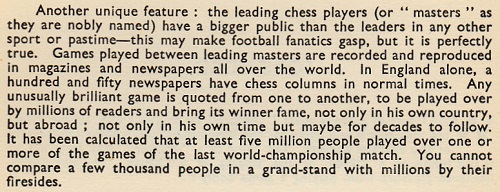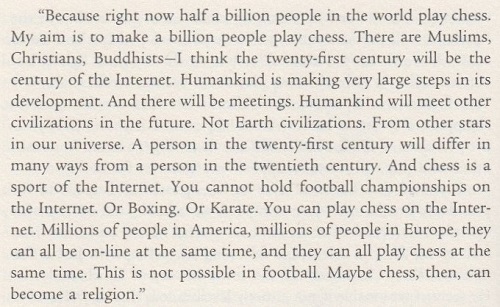
Edward Winter

Closing caption in the documentary Bobby Fischer Against the World (C.N. 7345)
All kinds of figures are bandied about – 600 million or so here, a billion or so there – in attempts to demonstrate that more people play chess than may be supposed or hoped. Recent claims, never based on solid evidence, have been well chronicled elsewhere (see, for instance, this index), and our notes on the subject avoid duplication of such material. Our quotes, though, have plenty of duplication of flimsy phrases like ‘it is estimated that ...’
From page 6 of the first edition of B.H. Wood’s Easy Guide to Chess (Sutton Coldfield, 1942):

A sentence which stands out:
‘It has been calculated that at least five million people played over one or more of the games of the last world championship match.’
Calculated how, and by whom?
100% of statistics about the popularity of chess should be distrusted by 100% of chess writers.
(8895)
Two little pensées have recently been added to Chess Jottings:
From the unsigned Foreword to Arthur M. Stevens’ The Blue Book of Charts to Winning Chess (C.N. 9537), pages ix-x:
‘Looked upon with great favor, the top Soviet players are rewarded with fringe benefits such as superior living accommodations and are subsidized with a state-paid salary.
Is it any wonder, then, that today in Russia there are 625 registered chessplayers per 100,000 population as compared to two serious players per 100,000 population in the United States? In all, some 14,000,000 persons are chess devotees in Russia, and less than 4,000,000 in America.
True, it has been estimated that as many as 15 million Americans play chess. But, Stevens notes, “Most of them play chess the way most people play bridge – not very seriously.”’
As mentioned in C.N. 9537, Stevens’ book was published in 1969.
An article by Xu Jialiang on pages 6-7 of the November 1979 CHESS was entitled ‘200 Million Potential Chess Champions Join the Lists’ and offered the following:
‘For the truth is that Chinese chess players have not been dozing – but simply playing a different game.
In fact, it is estimated that almost a quarter of China’s 900 million or so inhabitants are keen chess players – as have been generations of Chinese since the time of Confucius 2,500 years ago.
In those days, they played a game called “wei qi”...’
Concerning what CHESS termed ‘our chess’, the article added:
‘There are now estimated to be about 100,000 international chess players in China.’
And:
‘The Chinese Chess Association has more than 5,000 members, all of whom are up to provincial tournament standard.’
Another passage picked at random, from an obvious source, is on page 8 of Alpha Teach Yourself Chess in 24 Hours by Zsuzsa Polgar, Hoainhan “Paul” Truong and Leslie Alan Horvitz (Indianapolis, 2002/2003):
‘Today, according to recent polls, 25-30 million people play chess in the United States alone. Worldwide, chess is played in more than 150 countries, and it is estimated that hundreds of millions of people know how to play chess.’
Many other claims about the number of chessplayers, whether worldwide or in particular countries, could easily be cited, all lacking any indication as to where the figures originated. Already above, we have seen ‘it has been estimated that ...’, ‘it is estimated that...’ and ‘there are now estimated to be ...’, as well as ‘according to recent polls’. Other airy options include ‘It has been shown by studies that ...’, and these impersonal and passive constructions help circumvent the need to identify the estimators, pollsters and studiers.
Not that such pseudo-corroborative expressions are needed at all. The following ipse dixit comes from an interview with Kirsan Ilyumzhinov by Tim Redman on page 36 of Chess Life, November 2002:
‘Right now half a billion people play chess. I want it to grow to a billion.’
The published interview does not record that Mr Redman sought substantiation of the statistics, or an explanation of what ‘play chess’ means.
From another interview with the FIDE President, this appeared on page 176 of The Chess Artist by J.C. Hallman (New York, 2003):

Any future C.N. items on this topic will continue to focus on claims recorded in books and magazines, and not least claims from former times. When, for instance, was an estimate of the number of chessplayers worldwide first put forward?
(9538)
‘There are now estimated to be about 100,000 international chess players in China.’
Christian Rau (Rüsselsheim, Germany) comments that that sentence in an article on pages 6-7 of the November 1979 CHESS which was quoted in C.N. 9538 (see above) could be misinterpreted. It is not a reference to players of international standard; ‘international chess’ is the precise translation of the Chinese term (国际象棋) for the ordinary English word ‘chess’.
(11791)
On 1 May 2016 Justin Horton posted an article, Think of a number, with a link to a video presentation in which ‘600 million’ tripped off Daniel Roberts’ tongue and, concerning the United States, ‘about 30 million’ tripped off Maurice Ashley’s.
The latter figure deserves special attention, since it indicates remarkable stability in the game’s imagined popularity. As mentioned in C.N. 9880, 30 million was the number given by Lev Alburt on page 9 of Chess Life, December 1985. Over 30 years before that, the following appeared on page 5 of Championship Chess and Checkers for All by Larry Evans and Tom Wiswell (New York, 1953):
‘A recent survey revealed that there are upwards of 30,000,000 chess and checker sets in American homes. Thirty million Americans can’t be wrong!’
A decade ago, however, the United States Chess Federation suggested that the 30 million figure applied only to children. This, for instance, was in a USCF advertisement on page 70 of the July 2006 Chess Life:
‘It is estimated that there are more than 30 million children who play chess in America. This number is growing rapidly.’
Or, again, from page 5 of Players and Pawns by Gary Alan Fine (Chicago, 2015):
‘Estimates of the number of children playing chess run as high as thirty million.’
On the other hand, when the American Chess Foundation played the ‘it is estimated’ game in an advertisement on page 356 of Chess Review, December 1957 its estimate was both lower and vaguer, while also including the words ‘know how to’:
‘It is estimated that from ten to fifteen million people in the United States know how to play the game of chess.’
Nobody knows, even roughly, how many people play chess, and nobody should pretend to know.
A rare old estimate of the number of chessplayers in the United States was made by C.S. Howell in an article entitled ‘The Ingratitude of the Chess Public’ on pages 25-26 of the American Chess World, February 1902:
‘There are somewhat over two thousand chessplayers in the United States (estimated).’
On page 34 of the same issue an editorial note referred to ‘C.S. Howell’s eloquent arraignment, which, by the way, seems to err by underestimate, as we believe that there are at least ten thousand chessplayers in the United States’.
There was no indication as to how either estimate had been made.
(10208)
From page 379 of CHESS, 18 June 1955:
‘A correspondent queries the statement in a recent Reader’s Digest that there are a hundred million chessplayers in the world. We should give 20 million as a more reasonable figure.’
(11120)
A paragraph from page 368 of Lasker’s Manual of Chess (New York, 1927), in the chapter entitled ‘Final reflections on education in chess’:
‘Most chessplayers slowly climb to a certain rather low level and stay there. Of players to whom a master can give the odds of the queen there are millions; players of greater skill count probably no more than a quarter of a million. If we reckon the number of rook-odds players as a hundred and fifty thousand, of knight-odds players as fifty thousand, of pawn and two-move odds players as forty thousand, of pawn and move odds players as nine thousand, and the number of those to whom no master can allow odds as one thousand, we are likely not to be far wrong.’
The wording was slightly different on page 336 of the more readily available 1932 and 1947 editions, but the figures were the same.
(11147)
More figures advanced in Lasker’s Manual of Chess (New York, 1927), page 369:
‘In fact, there are a quarter of a million chess friends who devote to chess at least two hundred hours every year, and of these only a thousand, after a lifetime of study, attain the end. Without losing myself in calculations, I believe I am safe in voicing the opinion that our efforts in chess attain only a hundredth of one per cent of their rightful result.’
(11196)
To the Chess Notes main page.
To the Archives for other feature articles.
Copyright: Edward Winter. All rights reserved.